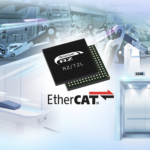Renesas Electronics Corporation, a supplier of advanced semiconductor solutions, has introduced the third-generation DDR5 registered clock driver (RCD) and first-generation client clock driver (CKD) for emerging DDR5 DRAM servers and client systems.
 With these new driver ICs, Renesas continues to be the only provider to offer a complete portfolio of DDR5 memory interfaces for dual inline memory modules (DIMMs), motherboards, and embedded applications.
With these new driver ICs, Renesas continues to be the only provider to offer a complete portfolio of DDR5 memory interfaces for dual inline memory modules (DIMMs), motherboards, and embedded applications.
The DDR5 RCD and DDR5 CKD ICs enable the next generation of DIMMs with speeds of up to 6400 and 7200 mega-transfers per second (MT/s), respectively, an increase from today’s 5600 MT/s transfer speeds.
Renesas’ Gen 3 DDR5 RCD is designed for registered DIMMs (RDIMMs). The CKD supports speeds up to 7200 MT/s and is the first in the industry to interface with small-outline DIMMs (SODIMMs), unbuffered DIMMs (UDIMMs), high-performance gaming DIMMs and memory down applications for client platforms.
“As the industry’s leading provider of memory interface products, Renesas continues to make outstanding contributions in pushing the memory eco-system to new frontiers of performance and power,” said Balaji Kanigicherla, corporate VP and GM of the Advanced Mixed Signal and ASIC Solutions Division at Renesas. “By playing an integral role in defining and implementing DDR5 interface specifications, Renesas continues to be an important partner for the world’s leading SOC and DRAM players for DIMM and system-level bring up.”
The RCD driver buffers the command address (CA) bus, chip selects and clock between the host controller and DRAM modules, in addition to creating a BCOM bus to control LRDIMM data buffering. The new driver enhances decision-feedback equalizer (DFE) support by increasing the DFE taps from four to six to improve receiver margin, while I2C and I3C sideband bus support provides direct contact to the register access control.
The CKD buffers the clock between the host controller and DRAM, which is a new requirement for DDR5 DIMMs operating at speeds of up to 7200 MT/s for client DIMMs and memory down applications.
The new clock driver supports I2C and I3C sideband access to enable asynchronous control and provides access to internal control words for configuring device features and adapting to different SODIMM and UDIMM configurations and memory down system applications.
“Intel Xeon-based platforms are designed to support memory intensive usages like predictive analytics that use deep learning and machine learning. Gen 3 RCD is a major milestone for the memory industry to help meet the bandwidth and scaling capacity needs of our datacenter customers,” said Dr. Dimitrios Ziakas, VP of Memory and IO Technologies at Intel. “The client clock driver is a new industry initiative to further enhance the client DIMM. Renesas and Intel have been collaborating with the industry to help ensure specification and implementations of the Gen 3 RCD and client clock driver to meet the market needs.”
You may also like:
Filed Under: Components, Memory, News






Questions related to this article?
👉Ask and discuss on Electro-Tech-Online.com and EDAboard.com forums.
Tell Us What You Think!!
You must be logged in to post a comment.